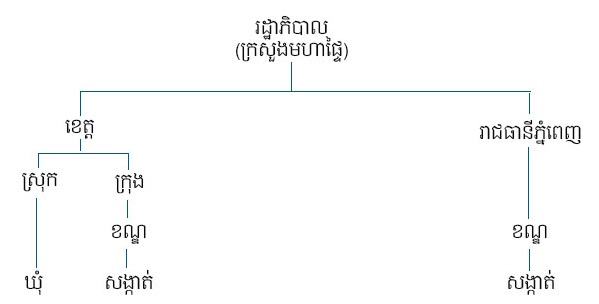កំណើនថវិកាជាតិ
នៅក្នុងរយៈពេលបីឆ្នាំចុងក្រោយនេះ ថវិកាជាតិរបស់ប្រទេសកម្ពុជា បានមានការកើនឡើងគួរឱ្យកត់សម្គាល់ ជិតប្រមាណ ១.៦ ពាន់លានដុល្លារអាមេរិក ដែលចំនួននេះកើនពី ៣.៤ ពាន់លានដុល្លារអាមេរិកនៅក្នុងឆ្នាំ ២០១៤3 មក ៥ ពាន់លានដុល្លារអាមេរិកនៅក្នុងឆ្នាំ ២០១៧។4 កំណើនមធ្យមប្រចាំឆ្នាំ គឺស្ទើរតែ ១៤ ភាគរយ។ ការកើនឡើងនេះ គឺអាចជាផ្នែកមួយបណ្តាលមកពីកំណើនសេដ្ឋកិច្ចដ៏ឆាប់រហ័សរបស់ប្រទេសកម្ពុជា ជាធម្មតាកំណើនផលិតផលក្នុងស្រុកសរុប (GDP)មានប្រហែល ៧ ភាគរយ ក្នុងរយៈពេលប៉ុន្មានទស្សវត្សនេះ និងមួយផ្នែកទៀតបានមកពីកិច្ចខិតខំប្រឹងប្រែងរបស់រដ្ឋាភិបាលក្នុងការប្រមូលពន្ធ។ នៅក្នុងឆ្នាំនេះ ដើម្បីសម្រេចគោលដៅចំណូលថវិការដ្ឋ ក្រសួងសេដ្ឋកិច្ច និងហិរញ្ញវត្ថុ តាមរយៈនាយកដ្ឋានគយ និងនាយកដ្ឋានពន្ធដារ បានប្តេជ្ញាចិត្តថានឹងប្រមូលចំណូលឱ្យបានចំនួន ៨.២៩ ភាគរយ និង ៧.៧៤ ភាគរយនៃផលិតផលក្នុងស្រុកសរុប (GDP)។5
ជីវភាពរស់នៅរបស់ប្រជាជន៖ ផលប៉ះពាល់នៃថវិកាជាតិ និងឧបសគ្គនានា
ជារៀងរាល់ឆ្នាំ រាជរដ្ឋាភិបាលកម្ពុជា បានប្រមូល និងចំនាយថវិការាប់ពាន់លានដុល្លារ។ ប្រាក់ទាំងនោះបានមកពីប្រភពផ្សេងៗគ្នាជាច្រើន រួមមាន ពន្ធ និងចំណូលមិនមែនពន្ធ, ជំនួយឧបត្ថម្ភ, និងកម្ចីឥណទាននានា។ នៅក្នុងការរស់នៅប្រចាំថ្ងៃ ប្រជាជនកម្ពុជា ចំនាយពន្ធលើតម្លៃបន្ថែម (VAT) ជាមួយនឹងការទូទាត់ចំនាយរបស់ពួកគេ ចាប់ពីប្រេងសាំង រហូតដល់ការបរិភោគអាហារនៅតាមភោជនីយដ្ឋាន និងការចំនាយលើពន្ធប្រាក់ចំណូលសម្រាប់ប្រាក់ខែ និងភាគលាភនានា។ យ៉ាងណាមិញ ប្រជាជនទូទៅកម្រនឹងលើកឡើងនូវសំណួរនានាអំពី ថាតើប្រាក់ទាំងនោះត្រូវបានចំនាយយ៉ាងដូចម្ត៉េចដោយរដ្ឋាភិបាល ហើយការចំនាយថវិកាទាំងនេះកំពុងផ្តល់ផលប៉ះពាល់របៀបណាដល់ជីវភាពរស់នៅរបស់ពួកគេនោះទេ។
ការវិនិយោគសាធារណៈស្តីពីវិស័យអាទិភាពនានាដើម្បីសម្រេចគោលនយោបាយជាតិរបស់រដ្ឋាភិបាល ត្រូវបានគេរំពឹងថា នឹងចូលរួមចំណែកដល់កំណើនសេដ្ឋកិច្ច, ការកាត់បន្ថយភាពក្រីក្រ និងការកែលម្អនៃលក្ខខណ្ឌរស់នៅរបស់ប្រជាជន។ យ៉ាងណាមិញ ក្រៅពីការកាត់បន្ថយភាពក្រីក្រដ៏គួរឱ្យកត់សម្គាល់ ពី ៥០ ភាគរយនៅក្នុងឆ្នាំ២០០៤ មកត្រឹម ១៣ ភាគរយនៅក្នុងឆ្នាំ ២០១៤6 ធនាគារពិភពលោកបានប្រាប់ឱ្យមានការប្រុងប្រយ័ត្នថា “ប្រជាជនកម្ពុជាជាច្រើនបានផ្លាស់ប្តូរពីក្រីក្រ ទៅងាយរងគ្រោះ” នេះមានន័យថា គ្រាន់តែមានការរំខានតែ ០.៣០ ដុល្លារអាមេរិកក្នុងមួយថ្ងៃ អាចបណ្តាលឱ្យអត្រានៃភាពក្រីក្ររបស់ប្រទេសកម្ពុជាកើនឡើងទ្វេដង។7 តើវាមានន័យយ៉ាងណា ប្រសិនបើកម្មកររោងចក្រកាត់ដេរជាច្រើនក្នុងចំនោម ៧០០,០០០នាក់ មិនមានអារម្មណ៍ថា ពួកគេមានភាពល្អប្រសើរបន្ទាប់ពីចំនាយពេលធ្វើការងាររាប់ម៉ោងក្នុងមួយថ្ងៃ ប៉ុន្តែពួកគេនៅតែជួបបញ្ហាក្នុងការផ្គត់ផ្គង់ការចំនាយចាំបាច់ប្រចាំថ្ងៃ?8
រាល់ព័ត៌មាន និងឯកសារដែលពាក់ព័ន្ធនានាស្តីពីថវិកាជាតិ ពុំអាចស្វែងរកបាន ឬមានតម្លាភពនោះទេ។ ខណៈដែលម្ចាស់ជំនួយអន្តរជាតិនានា បានគូសបញ្ជាក់ពីការព្រួយបារម្ភលើការចាត់ចែងធនធាន និងតម្លាភាព9 គណបក្សប្រឆាំងដ៏សំខាន់បានអះអាងថា ថវិកាជាតិចូលរួមចំណែកតិចតួចនៅក្នុងកម្មវិធីសង្គម ហើយការពឹងផ្អែកលើកម្ចីឥណទានបរទេសរបស់ប្រទេសកម្ពុជា អាចនឹងត្រូវបានកាត់បន្ថយដោយសារការលើកកម្ពស់តម្លាភាពនៃថវិកា។10 ក្រៅពីការដាក់ចេញនូវ ច្បាប់ស្តីពីលទ្ធកម្មសាធារណៈ ដើម្បីឆ្លើយតបទៅនឹងសំណើររបស់ធនាគារពិភពលោក និងធនាគារអភិវឌ្ឍន៍អាស៊ីនៅក្នុងឆ្នាំ ២០១២11 ករណីសូកប៉ាន់នៅក្នុងកម្មវិធីមូលនិធិសកលត្រូវបានរកឃើញ។ មន្ត្រីសុខាភិបាលជាន់ខ្ពស់របស់រដ្ឋាភិបាលពីរនាក់ត្រូវបានរាយការណ៍ថា មានជាប់ពាក់ព័ន្ធនៅក្នុងការផ្ដល់កិច្ចសន្យាលទ្ធកម្មដោយខុសច្បាប់ និងមិនស្មើភាព ប៉ុន្តែមិនមានសកម្មភាពតាមផ្លូវច្បាប់ណាមួយត្រូវបានអនុវត្តន៍ដោយអង្គភាពប្រឆាំងអំពើពុករលួយ ឬមន្ត្រីតុលាការនោះទេ។12 ក្រោមការដាក់ពិន្ទុសម្រាប់ “ការចំនាយមិនទៀតទាត់ និងការសូកប៉ាន់” ប្រទេសកម្ពុជាត្រូវបានគេដាក់ចំណាត់ថ្នាក់ឱ្យស្ថិតនៅលេខរៀងទី ១១៤ ក្រោមគេ (ក្នុងចំនោមបណ្តាប្រទេសចំនួន ១៣៨) នៅក្នុងរបាយការណ៍ប្រកួតប្រជែងជាសកលឆ្នាំ ២០១៦-២០១៧។13 នៅក្នុងសន្ទស្សន៍ប្រកួតប្រជែងជាសកល ប្រទេសកម្ពុជាត្រូវបានស្ថិតនៅលេខរៀងទី ៨៩។14
ស្ថានភាពបំណុលសាធារណៈនៅក្នុងប្រទេសកម្ពុជា
ចាប់តាំងពីឆ្នាំ ១៩៩៣ ដល់ឆ្នាំ ២០១៦ យោងតាមទិន្នន័យបានមកពីក្រសួងសេដ្ឋកិច្ច និងហិរញ្ញវត្ថុ រាជរដ្ឋាភិបាលកម្ពុជាបានចុះហត្ថលេខាលើកិច្ចព្រមព្រៀងខ្ចីឥណទានសម្បទានជាមួយដៃគូអភិវឌ្ឍន៍នានា ប្រមាណ ៨,៣០៩.៨១ លានដុល្លារអាមេរិក។15 រាជរដ្ឋាភិបាលកម្ពុជាបានដកសាច់ប្រាក់យកមកប្រើប្រាស់ជាក់ស្តែងសរុបចំនួន ៥,៧៩៧.០៩ លានដុល្លារអាមេរិក ស្មើនឹងប្រមាណ ៦៩.៧៦ ភាគរយនៃទំហំឥណទានសម្បទានសរុប ដែលក្នុងនោះ ៨៦.៤៧ភាគរយ ត្រូវបានប្រើប្រាស់ដើម្បីហិរញ្ញប្បទានលើគម្រោងវិនិយោគសាធារណៈក្នុងវិស័យហេដ្ឋារចនាសម្ព័ន្ធ។16
យោងតាមស្ថិតិដែលចេញផ្សាយដោយក្រសួងសេដ្ឋកិច្ច និងហិរញ្ញវត្ថុ ជារៀងរាល់ឆ្នាំ កម្ចីឥណទានសម្បទានរបស់កម្ពុជា បានក្លាយជាផ្នែកមួយដ៏សំខាន់នៃថវិកាជាតិ ជាមួយនឹងការពឹងផ្អែកយ៉ាងខ្លាំងទៅលើកម្ចីឥណទានទ្វេភាគីជាងកម្ចីឥណទានពហុភាគី។ ចាប់តាំងពីឆ្នាំ ២០១៣ មកដល់ឆ្នាំ ២០១៦ កម្ចីឥណទានសម្បទានទ្វេភាគី បានកើនឡើងដល់ ៦៨ ភាគរយនៃចំនួនកម្ចីទាំងអស់។ ជាងពាក់កណ្តាលនៃកម្ចីឥណទានទ្វេភាគីសរុប - ២.១២ ពាន់លានដុល្លារ- ត្រូវបានខ្ចីពីប្រទេសចិន។ រាជរដ្ឋាភិបាលកម្ពុជា ជាពិសេសក្រសួងសាធារណការ និងដឹកជញ្ជូន បានបង្កើនការផ្តល់ព័ត៌មានស្តីពីគម្រោងហេដ្ឋារចនាសម្ព័ន្ធ ដែលអាចសាធារណជនស្វែងរកបាន រួមទាំងព័ត៌មានអំពីប្រទេសម្ចាស់បំណុល និងកាលកំណត់ពេលវេលារបស់គម្រោងផងដែរ ប៉ុន្តែមិនមានតួលេខអំពីចំនួននៃកម្ចី និងអត្រាការប្រាក់នោះទេ។ យ៉ាងណាមិញ អង្គការទិន្នន័យ (China) AidData ដែលជាអង្គការមួយក្នុងចំនោមអង្គការទិន្នន័យបើកទូលាយដែលកំពុងធ្វើការស្តីពីហិរញ្ញវត្ថុអភិវឌ្ឍន៍របស់ប្រទេសចិន បាននិងកំពុងតាមដានពីគម្រោងកម្ចីឥណទានសម្បទាននានារបស់ប្រទេសចិនដែលផ្តល់ឱ្យមកប្រទសកម្ពុជា។ អង្គការនេះបានកត់ត្រាពីអត្រាការប្រាក់ដែលមានចាប់ពី ១.២៥ ភាគរយ ដល់ ៣ ភាគរយ អាស្រ័យលើវិស័យនៃគម្រោង និងប្រភេទនៃអង្គភាពឥណទាន-តាមរយៈរដ្ឋាភិបាលចិន ឬតាមរយៈធនាគាររបស់រដ្ឋ។17
លទ្ធកម្មសាធារណៈនៅកម្រិតថា្នក់ជាតិ និងកម្រិតថ្នាក់ក្រោមជាតិ
នៅក្នុងប្រទេសកម្ពុជា រាល់សកម្មភាពនានានៃការទិញទំនិញ ការងារសាងសង់ ការជួសជុស សេវាកម្មនានា និងការងារប្រឹក្សាយោបល់ដែលផ្តល់ដោយរដ្ឋាភិបាល ក្រសួង និងទីភ្នាក់ងារនានារបស់រដ្ឋាភិបាលគួរតែទទួលខុសត្រូវដោយយោងតាមច្បាប់ស្តីពីលទ្ធកម្មសាធារណៈឆ្នាំ ២០១២។ នីតិវិធីនានាសម្រាប់វិធីសាស្ត្រនៃការអនុវត្តជាក់លាក់មួយនៃលទ្ធកម្មសាធារណៈ ត្រូវបានដាក់ជាប្បញ្ញត្តិនៅក្នុងអនុក្រឹត្យស្តីពីលទ្ធកម្មសាធារណៈឆ្នាំ ២០០៦។ វិធាននៃលទ្ធកម្មសាធារណៈនានា មានគោលបំណងដើម្បីធានាថា ការចំនាយនានារបស់រដ្ឋ ត្រូវបានគ្រប់គ្រងដោយមានប្រសិទ្ធិភាព និងប្រសិទ្ធិផល ហើយត្រូវបានត្រួតពិនិត្យដោយមានដំណើរការតម្លាភាព ត្រឹមត្រូវ និងសន្សំសំចៃពេលវេលា។
ដ្យាក្រាម ១: រចនាសម្ព័ន្ធតាមទិសដេកនៃស្ថាប័នក្រសួង18
លទ្ធកម្មសាធារណៈអាចនឹងត្រូវអនុវត្តតាមរយៈវិធីសាស្ត្រផ្សេងៗ។ វិធីសាស្ត្រទាំងនេះ អាចនឹងត្រូវធ្វើចំណាត់ថ្នាក់ជា៖
- ការដេញថ្លៃតាមរយៈការប្រកួតប្រជែងលក្ខណៈអន្តរជាតិ
- ការដេញថ្លៃតាមរយៈការប្រកួតប្រជែងក្នុងស្រុក
- ការប្រឹក្សាតម្លៃ
- ការស្ទាបស្ទង់តម្លៃ19
រាល់លទ្ធកម្មទាំងអស់ គួរតែដំណើការតាមរយៈវិធីសាស្ត្រមួយក្នុងចំនោមវិធីសាស្ត្រទាំងបួននេះ។ ដោយបន្ថែមលក្ខខណ្ឌវិនិច្ឆ័យទៅក្នុងវិធីសាស្ត្រនីមួយៗនោះ ដូចជា តម្លៃអប្បបរមានៃការដេញថ្លៃ, ធនធានក្នុងស្រុក (សេវាកម្ម និងទំនិញនានា) ដែលពាក់ព័ន្ធ និងសមត្ថភាពបច្ចេកទេស។
តម្លៃសម្រាប់វិធីសាស្ត្រនីមួយៗនៃលទ្ធកម្មសាធារណៈ ប្រហែលជាអាចប្រែប្រួល រវាងរដ្ឋបាលថ្នាក់ជាតិ និងថ្នាក់ក្រោមជាតិ។ តម្លៃនៃការដេញថ្លៃសម្រាប់ការប្រកួតប្រជែងលក្ខណៈអន្តរជាតិនៅកម្រិតក្រសួង រាជធានី ខេត្ត និងគ្រឹះស្ថានសាធារណៈនានា គួរតែចាប់ពីតម្លៃ ៥ ពាន់លានរៀលឡើង ខណៈដែលតម្លៃនៃការដេញថ្លៃសម្រាប់វិធីសាស្ត្រដូចគ្នានៅកម្រិតថ្នាក់ក្រុង ស្រុក ខណ្ឌ គឺតិចជាង ២ ពាន់លានរៀល។20 ច្បាប់ហាមប្រាមការប្រព្រឹត្តខុសណាមួយនៃលក្ខខណ្ឌដេញថ្លៃ ដែលមានគោលបំណងដើម្បីបញ្ចៀសដំណើការលទ្ធកម្មសាធារណៈ ជាមួយនឹងលក្ខខណ្ឌទ័ណ្ឌកម្មនានា។21
ដ្យាក្រាម ២: រចនាសម្ព័ន្ធនៃរដ្ឋបាលថ្នាក់ក្រោមជាតិនៃប្រទេសកម្ពុជា
ស្ថាប័នអនុវត្តន៍លទ្ធកម្មនៅក្នុងគ្រឹះស្ថានផ្សេងៗគ្នា គួរតែធ្វើយ៉ាងណាឱ្យព័ត៌មានស្តីពីការដេញថ្លៃអាចឱ្យសាធារណជនស្វែងរក។22 ចាប់តាំងពីខែកុម្ភៈ ឆ្នាំ ២០១១ មក ព័ត៌មានស្តីពីការដេញថ្លៃតាមរយៈការប្រកួតប្រជែងលក្ខណៈអន្តរជាតិ និងការដេញថ្លៃតាមរយៈការប្រកូតប្រជែងក្នុងស្រុកត្រូវបានដាក់ឱ្យស្វែងរកបាននៅលើគេហទំព័ររបស់ក្រសួងសេដ្ឋកិច្ច និងហិរញ្ញវត្ថុ (ទំនិញ, សំណង់, សេវាកម្ម, និងសេវាកម្មប្រឹក្សាយោបល់)។ សេចក្តីប្រកាសព័ត៌មាននានានៃការដេញថ្លៃនៅថ្នាក់ស្រុក និងគម្រោងនានាថ្នាក់ឃុំ/សង្កាត់ អាចស្វែងរកបាន នៅលើគេហទំព័ររបស់ គណៈកម្មាធិការជាតិសម្រាប់ការអភិវឌ្ឍតាមបែបប្រជាធិបតេយ្យនៅថ្នាក់ក្រោមជាតិ (គជអប) និង ការិយាល័យច្រកចេញចូលតែមួយ។ សេចក្តីប្រកាសព័ត៌មានទាំងនេះ ក៏អាចស្វែងរកបាននៅលើគេហទំព័រក្រសួងនានា ដូចជា ក្រសួងអប់រំ យុវជន និងកីឡា និងក្រសួងសាធារណការ និងដឹកជញ្ជូនផងដែរ។
បច្ចុប្បន្នភាពចុងក្រោយ៖ ២៤ មេសា ២០១៧
ឯកសារយោង
- 1. វង្ស សុខេង. “សេចក្តីព្រាងច្បាប់ថវិកាជាតិនឹងត្រូវអនុម័តក្នុងពេលឆាប់ៗ.” កាសែតភ្នំពេញប៉ុស្តិ៍, ចុះថ្ងៃទី ១២ ខែ វិច្ឆិកា ឆ្នាំ ២០១៣. ចូលអាចនៅថ្ងៃទី ២៣ ខែ មេសា ឆ្នាំ ២០១៧។ https://www.phnompenhpost.com/national/budget-passes-sans-opposition
- 2. ម៉ៃ គុណមករា. “ថវិកាសម្រាប់ឆ្នាំ ២០១៧ នឹងកើនដល់ ៥ ពាន់លានដុល្លារ.” កាសែតខ្មែរថាមស៍, ចុះថ្ងៃទី ២០ ខែតុលា ឆ្នាំ ២០១៦. ចូលអានថ្ងៃទី ២៣ ខែ មេសា ឆ្នាំ ២០១៧. https://www.khmertimeskh.com/61388/budget-for-2017-to-increase-by-5-bil/
- 3. វង្ស សុខេង. “សេចក្តីព្រាងច្បាប់ថវិកាជាតិនឹងត្រូវអនុម័តក្នុងពេលឆាប់ៗ.” កាសែតភ្នំពេញប៉ុស្តិ៍, ចុះថ្ងៃទី ១២ ខែ វិច្ឆិកា ឆ្នាំ ២០១៣. ចូលអាចនៅថ្ងៃទី ២៣ ខែ មេសា ឆ្នាំ ២០១៧។ https://www.phnompenhpost.com/national/budget-passes-sans-opposition
- 4. ម៉ៃ គុណមករា. “ថវិកាសម្រាប់ឆ្នាំ ២០១៧ នឹងកើនដល់ ៥ ពាន់លានដុល្លារ.” កាសែតខ្មែរថាមស៍, ចុះថ្ងៃទី ២០ ខែតុលា ឆ្នាំ ២០១៦. ចូលអានថ្ងៃទី ២៣ ខែ មេសា ឆ្នាំ ២០១៧. https://www.khmertimeskh.com/61388/budget-for-2017-to-increase-by-5-bil/
- 5. ហ៊ គឹមសាយ. “ថវិកាជាតិនឹងកើនឡើងជាមួយនឹងកំណើនសេដ្ឋកិច្ចឆ្នាំ២០១៧.” កាសែតភ្នំពេញប៉ុស្តិ៍, ចុះថ្ងៃទី ១៥ ខែ មិថុនា ឆ្នាំ ២០១៦. ចូលអានថ្ងៃទី ២៣ ខែ មេសា ឆ្នាំ ២០១៧. https://www.phnompenhpost.com/business/budget-swell-economy-2017-govt-official
- 6. Logan Connor. “កិច្ចពិភាក្សាអ្នកជំនាញធនាគារពិភពលោក ថាតើកម្ពុជានឹងរក្សាបាននូវកំណើនសេដ្ឋកិច្ចគួរឱ្យចាប់អារម្មណ៍របស់ខ្លួន.” សារព័ត៌មាន Southeast Asia Globe, ចុះថ្ងៃទី ១០ ខែ មីនា ឆ្នាំ ២០១៧. ចូលអានថ្ងៃទី ២៣ ខែ មេសា ឆ្នាំ ២០១៧។ https://southeastasiaglobe.com/world-bank-expert-on-whether-cambodia-will-maintain-its-impressive-growth/
- 7. Carlos Sobrado, Samsen Neak at al. តើប្រជាជនក្រីក្រទៅឯណា? ការសិក្សាវាយតម្លៃភាពក្រីក្រនៅកម្ពុជា ឆ្នាំ ២០១៣. ការសិក្សាមួយរបស់ប្រទេសសមាជិកធនាគារពិភពលោក (ACS4545). បោះពុម្ភលើកទីពីរ. ទីក្រុងវ៉ាស៊ីនតោន ឌីស៊ី: ធនាគារពិភពលោក, ខែ មេសា ឆ្នាំ ២០១៤. http://documents.worldbank.org/curated/en/824341468017405577/pdf/ACS45450REVISE00English0260May02014.pdf
- 8. Ate Hoekstra. “កម្មកររោងចក្រកាត់ដេរកម្ពុជានៅតែក្រីក្រខណៈដែលសម្លៀកបំពាក់នាំចេញទៅកាន់លោកខាងលិច.” សារព័ត៌មាន DW, ចុះថ្ងៃទី ០៣ ខែ មីនា ឆ្នាំ ២០១៧. ចូលអានថ្ងៃទី ២៣ ខែ មេសា ឆ្នាំ ២០១៧. http://www.dw.com/en/cambodian-garment-workers-stay-poor-while-dressing-the-west/a-37796952
- 9. Tej Parkh និងកាំង សុធា. “កង្វះនៃតម្លាភាពរារាំងវឌ្ឍនភាពថវិកា.” កាសែតខេមបូឌាដេលី, ចុះថ្ងៃទី ២៦ ខែ មីនា ឆ្នាំ ២០១៦. ចូលអានថ្ងៃទី ២៣ ខែ មេសា ឆ្នាំ ២០១៧. https://www.cambodiadaily.com/archives/lack-of-transparency-hinders-budget-progress-110437/
- 10. ហ៊ គឹមសាយ. “ថវិកាជាតិនឹងកើនឡើងជាមួយនឹងកំណើនសេដ្ឋកិច្ចឆ្នាំ២០១៧.” កាសែតភ្នំពេញប៉ុស្តិ៍, ចុះថ្ងៃទី ១៥ ខែ មិថុនា ឆ្នាំ ២០១៦. ចូលអានថ្ងៃទី ២៣ ខែ មេសា ឆ្នាំ ២០១៧. https://www.phnompenhpost.com/business/budget-swell-economy-2017-govt-official
- 11. ចាន់ មុយហុង. “ ACU នឹងពិនិត្យឡើងវិញពីគម្រោងដេញថ្លៃសាធារណៈ.” កាសែតភ្នំពេញប៉ុស្តិ៍, ចុះថ្ងៃទី ២៣ ខែ ធ្នូ ឆ្នាំ ២០១៤. ចូលអានថ្ងៃទី ២៣ ខែ មេសា ឆ្នាំ ២០១៧. https://www.phnompenhpost.com/business/acu-police-public-tender-process
- 12. មាស សុជា. “CNRP ហៅរដ្ឋមន្ត្រីក្រសួងសុខាភិបាលមកសាកសួរ.” កាសែតភ្នំពេញប៉ុស្តិ៍, ចុះថ្ងៃទី ០៧ ខែ ធ្នូ ឆ្នាំ ២០១៦. ចូលអានថ្ងៃទី ២៣ ខែ មេសា ឆ្នាំ ២០១៧. http://www.phnompenhpost.com/national/cnrp-eyes-health-checkup
- 13. វេទិកាសេដ្ឋកិច្ចពិភពលោក. “សន្ទស្សន៍ប្រកួតប្រជែងសកលលោក: ចំណាត់ថ្នាក់ភាពប្រកួតប្រជែង.” ចូលអានថ្ងៃទី ២៣ ខែ មេសា ឆ្នាំ ២០១៧. http://reports.weforum.org/global-competitiveness-index/competitiveness-rankings/#series=BRIBEIDX
- 14. វេទិកាសេដ្ឋកិច្ចពិភពលោក. “ សន្ទស្សន៍ប្រកួតប្រជែងសកលលោក: ព័ត៌មានអំពីសេដ្ឋកិច្ច, ប្រទេសកម្ពុជា.” ចូលអានថ្ងៃទី ២៣ ខែ មេសា ឆ្នាំ ២០១៧. http://reports.weforum.org/global-competitiveness-index/country-profiles/#economy=KHM
- 15. ក្រសួងសេដ្ឋកិច្ច និងហិរញ្ញវត្ថុ. ព្រឹត្តិបត្រស្ថិតិបំណុលសាធារណៈកម្ពុជា. លេខ ៣, ខែ មីនា ឆ្នាំ ២០១៧. http://www.mef.gov.kh/documents/shares/publication/public-debt-bulletin/Cambodia-Public-Debt%20Statistical-Bulletin-Vol-3.pdf
- 16. ដូចឯកសារយោងខាងដើម។
- 17. អង្គការ AidData. “ទិន្នន័យ: ស្វែងរកគម្រោងនានា.” ចូលអានថ្ងៃទី ២២ ខែ មេសា ឆ្នាំ ២០១៧. http://china.aiddata.org/
- 18. បញ្ជីនៃគ្រឹះស្ថានរដ្ឋបាលសាធារណៈ និងសហគ្រាសសាធារណៈ ត្រូវបានប្រមូល និងរៀបរៀងដោយកម្មវិធីកំណែទម្រង់ការគ្រប់គ្រងហិរញ្ញវត្ថុសាធារណៈ. ក្រសួងសេដ្ឋកិច្ច និងហិរញ្ញវត្ថុ. កម្មវិធីកំណែទម្រង់ការគ្រប់គ្រងហិរញ្ញវត្ថុសាធារណៈ (PFM): ការវាយតម្លៃ PFM នៅកម្ពុជា. សេចក្តីព្រាងទីពីរ, ថ្ងៃទី ០៨ ខែ កញ្ញា ឆ្នាំ ២០១៥. ចូលអានថ្ងៃទី ២២ ខែ មេសា ឆ្នាំ ២០១៧. http://pfm.gov.kh/Document/workshop/20151021/pefa_assessment_draft.pdf
- 19. អនុក្រឹត្យលេខ ១០៥ ស្តីពីលទ្ធកម្មសាធារណៈ (ចុះថ្ងៃទី ១៨ ខែ តុលា ឆ្នាំ ២០០៦), មាត្រា ៨.
- 20. ប្រកាស ស្តីពីទំហំសាច់ប្រាក់សម្រាប់អនុវត្តវិធីសាស្រ្តលទ្ធកម្ម លេខ ១៨៦៦ ចុះថ្ងៃទី ២៦ ខែធ្នូ ឆ្នាំ២០១៤។
- 21. ច្បាប់ស្តីពីលទ្ធកម្មសាធារណៈ (២០១២), មាត្រា ៣៣.
- 22. ច្បាប់ស្តីពីលទ្ធកម្មសាធារណៈ (២០១២), មាត្រា ៣៨.



